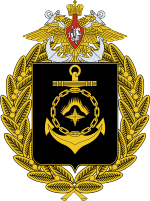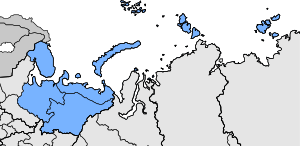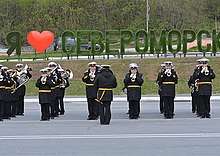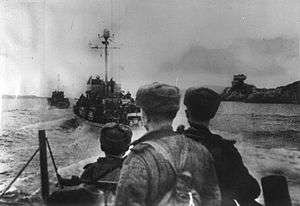Northern Fleet
The Northern Fleet (Russian: Северный флот, Severnyy flot) is the fleet of the Russian Navy in the Arctic.[1]
| Northern Fleet | |
|---|---|
| Russian: Северный флот Severnyy flot | |
 Northern Fleet's great emblem | |
| Founded | August 5, 1933 |
| Country | |
| Branch | |
| Type | Fleet |
| Role | Naval warfare Amphibious military operations and combat patrols in the Arctic and Atlantic oceans. |
| Size | 39 warships 42 submarines |
| Part of | |
| Garrison/HQ |
|
| Anniversaries | May 11th |
| Engagements | World War II |
| Decorations | |
| Commanders | |
| Current commander | V.-Adm. Aleksandr Moiseyev |
| Notable commanders | Adm. Vladimir Vysotskiy Adm. Feliks Gromov Adm. Ivan Kapitanets Adm. Vladimir Chernavin Adm. Semyon Lobov Adm. Vladimir Kasatonov Adm. Arseniy Golovko |
| on RT Documentary Official YouTube Channel(in English) | |
Established in 1933 by the Soviet Union as the Northern Flotilla, the fleet historically descends from the Russian Imperial Arctic Sea Flotilla established in 1916 to protect the White Sea during World War I. It was developed into a full fleet of the Soviet Navy in the 1930s, and after being awarded the Order of the Red Banner in 1965, it was officially known as the Red Banner Northern Fleet. During the Soviet era the Northern Fleet operated more than 200 submarines, ranging from diesel-electric to nuclear-powered ballistic missile classes. The Northern Fleet is tasked with responsibility for operations and defense in the Arctic seas along Northern Russia, including the Barents Sea and Kara Sea, as well as the northwestern maritime approaches to Russia including the Norwegian Sea and Atlantic Ocean.
The Northern Fleet's headquarters and main base are located in Severomorsk, Murmansk Oblast, with secondary bases elsewhere in the greater Kola Bay area. Today, the Northern Fleet is the basis of the Northern Fleet Joint Strategic Command (Russia), established in 2014 and which includes all Russian armed forces located in the Murmansk Oblast and Arkhangelsk Oblast, and on Russia's offshore islands along its northern coast. The current commander is Vice-Admiral Aleksandr Moiseyev, who has held the position since May 2019.
History
Arctic Sea Flotilla and White Sea Flotilla
On June 19, 1916, the Imperial Russian Navy formed the Arctic Ocean Flotilla (Флотилия Северного Ледовитого океана, or Flotiliya Severnogo Ledovitogo okeana) during World War I to safeguard transportation routes of Allied ships through the Barents Sea from the Kaiserliche Marine of the German Empire. After the October Revolution and the collapse of the Russian Empire in 1917, the Soviet Navy replaced the Imperial Russian Navy and formed the White Sea Flotilla (Беломорская флотилия, Belomorskaya flotiliya) in March 1920, based in Arkhangelsk. The White Sea Flotilla replaced the Arctic Sea Flotilla and was renamed as the Naval Forces of the North Sea, but was later disbanded in January 1923.
Soviet Navy
Northern Flotilla
The Northern Flotilla was formed on August 5, 1933, by transferring patrol boats Smerch and Uragan, D-class submarines Dekabrist (D-1) and Narodovolyets (D-2)[2] and two destroyers from the Baltic Fleet to Northern Russia. These ships departed from Kronstadt on 18 May 1933 and arrived at Murmansk on 5 August. Another destroyer, another patrol boat, another submarine, and two minesweepers joined the flotilla at Soroka in September 1933. Polyarny became the flotilla's main base; and a flight of MBR-2 flying boats joined the unit at Murmansk in September 1935.[2]
The Northern Flotilla was quickly expanded in the years after it was formed, receiving new ships, airfields, coastal and air defence artillery. On May 11, 1937, the fleet entered its current form when it was renamed to the Northern Fleet (Северный флот, Severnyy flot).[3]
World War II
The Northern Fleet blocked the Finnish military base at Petsamo through the Winter War of 1939 and 1940. By June 1941, the fleet included 8 destroyers, 15 submarines, 2 torpedo boats, 7 patrol boats, 2 minesweepers, and 116 airplanes.
In August 1940, the Soviets created the White Sea Military Base to defend the coastline, bases, ports, and other installations. The White Sea Flotilla was established in August 1941 under the command of Rear-Admiral M. Dolinin. Subsequent commanders were Vice Admiral Georgy Stepanov (in October), Rear-Admiral Stepan Kucherov, and Vice-Admiral Yuriy Panteleyev.
During the German-Soviet War of 1941 to 1945, the Northern Fleet defended the coastlines of the Rybachy and Sredny peninsulas, secured internal and external transportation routes, and provided support to the maritime flank of the 14th Army. Naval Infantry and up to 10,000 Northern Fleet personnel participated in land warfare including the Petsamo-Kirkenes Operation of 1944. Northern Fleet Naval Infantry units caused tens of thousands of Nazi casualties fighting during the Moscow, Leningrad, Stalingrad, and North Caucasus campaigns.[4]
Among the air units of the Northern Fleet was the 121st Fighter Aviation Regiment. The Northern Fleet was reinforced with naval aircraft and ships from the Pacific Ocean and Caspian Sea. Great Britain and the United States temporarily provided HMS Royal Sovereign and USS Milwaukee to the USSR in exchange for the Italian ships captured during the war and destined to be divided among the allies. During the war, the Northern Fleet secured safe passage for 1,463 ships in external convoys and 2,568 ships in internal convoys. Its submarines, torpedo boats, and aviation sank 192 enemy transport ships and 70 other hostile military ships. The Northern Fleet also damaged a total of 118 transport, military, and auxiliary ships.[5] Soviet submarine K-21, under the command of Captain Nikolai Lunin, attacked the German battleship Tirpitz at 71° 22' 2"N, 24° 34' 3"E.[6] The К-21 logbook reports observation of two torpedo explosions, but no damage is reported by German sources.
Ships were lost fighting against unequal odds. Patrol boat Tuman, a former trawler, was sunk by three Kriegsmarine destroyers at the entrance to Kola Bay on August 4, 1941. The icebreaker Sibiryakov was sunk on August 25, 1942 by the German pocket battleship Admiral Scheer while defending two convoys. The patrol ship Brilliant (formerly trawler Murmany) was sunk by a submarine.[7]
The Northern Fleet received the following awards:
- Two airborne regiments, a squadron of submarine hunters, eight submarines, and the destroyer Гремящий (Gremyaschiy, or "Rattler") were awarded "Soviet Guards" status.
- Many formations, units, and ships were awarded with Order honors.
- Eighty-five sailors of the Northern Fleet received the title of the Hero of the Soviet Union (with three of them receiving the award twice).
- More than a total of 48,000 men were awarded medals.
Cold War
The White Sea Flotilla was reestablished under the fleet in December 1945 and the White Sea Naval Base in December 1956.[8]
The Northern Fleet was considered secondary to the Baltic and Black sea fleets until operational responsibility for the Atlantic Ocean was shifted in the 1950s because of more direct access.[2] In September 1955, the Soviet navy became the first to launch a ballistic missile from a submarine. In June 1956, Northern Fleet Zulu class submarine, (NATO designation Zulu IV 1/2) “Б-67” (B-67) became the first to carry ballistic missiles.
The 2nd Cruiser Division was formed on 31 May 1956 at Severomorsk, Murmansk Oblast. Its ships included the Sverdlov class cruisers (Project 68) Murmansk, Aleksandr Nevskiy, and Molotovsk, and the 121st Destroyer Brigade, with 11 Gnevny class, Ognevoy class, and Skoryy class destroyers.[9] On 5 June 1969, the division was reorganised with the 170th Destroyer Brigade (8 Project 56 destroyers) and the 10th Anti-Submarine Warfare Brigade (10 Project 42 and 50 ASW vessels). On 1 April 1961, the division was renamed the 2nd Anti-Submarine Warfare Division.
On 1 July 1958, the Northern Fleet raised the Soviet Navy ensign over the first Soviet nuclear submarine, K-3 Leninskiy Komsomol. Following the 1958 voyage of USS Nautilus, the Leninskiy Komsomol (named for Vladimir Lenin's Komsomol) traveled under the Arctic ice and surfaced at the North Pole on 17 July 1962. Russian submarines have visited the North Pole region more than 300 times since then. Two nuclear submarines of the Northern Fleet made a journey under the Arctic ice cap and reached the Pacific Fleet for the first time in history in September 1963. More than 25 Soviet submarines did the same in the following years. The Northern Fleet was awarded the Order of the Red Banner on 7 May 1965. Two Northern Fleet submarines made a 25,000 nautical mile journey "around the world" (actually only between the Kola Gulf and the base at Petropavlovsk-Kamchatskiy around South America) without surfacing in 1966. The Northern Fleet had almost 50% of the Soviet Navy's submarines by 1986.[2]
From 1968 to 30 November 2005, the 7th Operational Squadron was the main Atlantic operational force of the fleet. The Museum of the Air Forces of the Northern Fleet was opened on 20 August 1976, in the closed settlement of Safonovo, Murmansk Oblast. Aircraft carriers began entering service with the Fleet in the 1970s. The lead unit of the Kiev class of heavy aircraft-carrying cruisers, Kiev, became operational in 1977, and Admiral Gorshkov was commissioned in 1987. Large nuclear-powered missile-carrying cruisers, the Kirov-class battlecruiser and Kalinin, also entered service from 1980. Fortification of the southern reaches of the Barents Sea during the 1980s marked a Soviet naval strategy shift to an emphasis on bastion defense. Russia has continued to employ that strategy.
In 1982, the 175th independent Naval Infantry Brigade was formed at Tumannyy, in Murmansk Oblast.[10]
Russian Navy


The 57th Naval Missile Aviation Division of Tu-22s and electronic warfare Tu-16s from the Baltic Fleet at Bykhov, Mogilev Oblast, in the Belorussian SSR transferred to the Northern Fleet in December 1991 as the 57th Combined Ship Aviation Division.[12] The division commanded the 830th and 38th Shipborne Anti-Submarine Helicopter Regiments and the 279th Shipborne Fighter Aviation Regiment from Severomorsk-3 in Murmansk Oblast until disbanded on 1 May 1998. The 5th Naval Missile Aviation Division commanding the 524th and 574th Naval Missile Aviation Regiments. The 574th Regiment was based at Lakhta air base (Katunino), until disbanded in 2002.
In February 1993, the 100th Independent Shipborne Fighter Aviation Regiment was disbanded and its personnel and equipment absorbed by the 279th Shipborne Fighter Aviation Regiment.[13]
On 12 August, 2000, the Kursk submarine disaster gained international attention when the Oscar-class submarine Kursk of the Northern Fleet perished in a torpedo accident during exercises in the Barents Sea near Murmansk Oblast, resulting in the deaths of 118 sailors.
The Northern Fleet includes about two-thirds of all the Russian Navy's nuclear-powered ships. The flagship Kirov-class battlecruiser Pyotr Velikiy is named after Peter the Great. The Fleet staged a series of major Barents Sea exercises in January 2004 involving thirteen ships and seven submarines including Pyotr Velikiy, Admiral Kuznetsov, with President Vladimir Putin was aboard the Typhoon class ballistic missile submarine Arkhangelsk. The exercise was marred by two RSM-54 SLBM launch failures aboard Novomoskovsk and Kareliya.[14]
In January 2016, Defence Minister Sergey Shoygu announced that the 45th Air Force and Air Defence Army had been formed under control of the Northern Fleet in December 2015. Its territorial control center assumed combat duty in July 2018.[15][16]
The Northern Fleet received the Samarkand electronic warfare systems in 2017. Samarkand is designed to assess electromagnetic situation, search, detect and analyze radio emissions.[17] Russia's Northern Fleet in 2018 resumed regular air patrols of the Arctic by long-range anti-submarine aircraft and its share of modern samples of weapons and equipment exceeded 56 percent.[18][19][20] An air defense regiment of the Northern fleet armed with S-400 launchers went on combat duty in Novaya Zemlya in the September 2019.[21]
A tank battalion of a Northern Fleet separate motorized infantry brigade has received the final batch of 26 T-80BVM tanks and completed the rearmament procedure in November 2019.[22]
Sites

The Northern Fleet main base is Severomorsk with six more naval bases at Polyarnyy, Olenya Bay, Gadzhiyevo (Yagelnaya/Sayda), Vidyayevo (Ura Bay and Ara Bay), Bolshaya Lopatka (Litsa Guba), and Gremikha. Civilian Arktika nuclear-powered icebreakers are based at Murmansk. Shipyards are located in Murmansk, Severodvinsk, Roslyakovo, Polyarnyy, Nerpa, and Malaya Lopatka. Spent fuel storage sites include Murmansk, Gremikha, Severodvinsk and Andreyeva Bay.
HQ Band

The Military Band of the Northern Fleet (Russian: Военный оркестр Северного флота) is a military band unit of the Russian Armed Forces that is a branch of the Military Band Service of the Armed Forces of Russia. It is based at the fleet HQ in Severomorsk. The band also takes part in national events and holidays in Russia such as the Victory Day and Defender of the Fatherland Day holidays as well as the Navy Day fleet parade. It has taken part in the ceremonial arrival of ships to the Northern Fleet Headquarters including the Vice-Admiral Kulakov[23] and the USS Nicholas.[24] It had taken part in the funerals of many of the victims of the Kursk submarine disaster in the fall of 2000.[25] In mid-March 2018, it took part in a competition at the Murmansk Nakhimov Naval School, which was presided by Colonel Timofey Mayakin, the Senior Director of Music of the Russian Armed Forces.[26] In September of that year, the band as well as a band from Tromsø, Norway, where they performed Norwegian March and Farewell of Slavianka at the Murmansk Regional Philharmonic.[27][28]
Order of battle
The following is a partial list of Northern Fleet submarines, ships, and air units currently in service. Among previous units was the 1st Submarine Flotilla including the 7th Submarine Division of nuclear attack submarines. The 6th and 3rd Submarine Divisions were disbanded in 1994 and 1995.[29]
- 11th Squadron, Zaozersk
- 12th Squadron, Gadzhiyevo
- Commander
- RADM Sergey Farkov [30]
- Commander
- 31st Submarine Division (Yagelnaya Bay, Sayda Inlet)
- Commander
- Captain 1st Rank Aleksandr Moiseyev [30]
- Delta class submarine IV-class SSBN Verkhoturye (K-51)
- Delta IV-class SSBN Ekaterinburg (K-84)
- Delta IV-class SSBN Tula (K-114)
- Delta IV-class SSBN Bryansk (K-117)
- Delta IV-class SSBN Karelia (K-18)
- Delta IV-class SSBN Novomoskovsk (K-407)
- Borei class SSBN Yury Dolgorukiy (K-535)[31]
- Borei class SSBN Knyaz Vladimir (K-549)[32]
- Commander
- 24th Submarine Division (Russia) (Yagelnaya Bay, Sayda Inlet)
- 43rd Missile Ship Division
- Commanders
- RADM Veregin
- RADM Sergei Avakyants
- RADM Vladimir Lvovich Kasatonov
- Present - RADM Aleksandr Turilin
- Commanders
- Kuznetsov-class CV Admiral Flota Sovetskogo Soyuza Kuznetsov (063), Navy flagship.
- Kirov-class battlecruiser CGN Pyotr Velikiy (099), Fleet flagship
- Slava-class CG Marshal Ustinov (055)
- Sovremennyy-class DDG Admiral Ushakov
- Admiral Gorshkov-class frigate Admiral Gorshkov
- 2nd Anti-Submarine Ship Division [30]
- Udaloy-I Class DDG Vice Admiral Kulakov
- Udaloy-I Class DDG Severomorsk
- Udaloy-I Class DDG Admiral Levchenko
- Udaloy-I Class DDG Admiral Kharlamov
- Udaloy-II Class DDG Admiral Chabanenko
- 4th Submarine Flotilla (Polyarny (ru)) [30]
- Commander
- Captain 1st Rank Aleksandr Gorbunov
- Kilo class submarine SS Novosibirsk (B-401)
- Kilo-class SS Vologda (B-402)
- Kilo-class SS Yaroslavl (B-808)
- Kilo-class SS Kaluga (B-800)
- Kilo-class SS Vladikavkaz (B-459)
- Kilo-class SS Magnitogorsk (B-471)
- Kilo-class SS Lipetsk (B-177)
- Commander
- Aviation Forces[33][34] - amended by removal of 100 KIAP, disbanded 1993.[35]
- 924th Independent Maritime Reconnaissance Aviation Regiment - HQ at Olenegorsk/Olenya - Tu-22M3; - all Tu-22Ms now transferred to Air Forces
- 279th Shipborne Fighter Aviation Regiment - HQ at Severomorsk-3 - Su-25UTG, Su-33;
- 73rd Independent Air Squadron - HQ at Kipelovo (Fedotovo) - Tu-142MK, Tu-142MR;
- 403rd Independent Mixed Aviation Regiment - HQ at Severomorsk-1 - An-12, An-26, Il-38, Tu-134;
- 830th Independent Shipborne Anti-Submarine Helicopter Regiment - HQ at Severomorsk-1 - Ka-27;

Commanders
| Name | Period of command |
|---|---|
| Zakhar Zakupnev (Flag Officer First Rank) | 29 May 1933 – 13 March 1935 Northern Flotilla |
| Konstantin Dushenov (Flag Officer First Rank) | 13 March 1935 – 11 May 1937 Northern Fleet 11 May 1937 – 28 May 1938 |
| Valentin Drozd (Vice Admiral) | 28 May 1938 – 26 July 1940 |
| Arseniy Golovko (Admiral) | 26 July 1940 – 4 August 1946 |
| Vasiliy Platonov (Admiral) | 4 August 1946 – 23 April 1952 |
| Andrey Chabanenko (Admiral) | 23 April 1952 – 28 February 1962 |
| Vladimir Kasatonov (Admiral) | 28 February 1962 – 2 June 1964 |
| Semyon Lobov (Fleet Admiral) | 2 June 1964 – 3 May 1972 |
| Georgiy Egorov (Fleet Admiral) | 3 May 1972 – 1 July 1977 |
| Vladimir Chernavin (Fleet Admiral) | 1 July 1977 – 16 December 1981 |
| Arkadiy Mikhaylovskiy (Admiral) | 16 December 1981 – 25 February 1985 |
| Ivan Kapitanets (Admiral) | 25 February 1985 – 19 March 1988 |
| Feliks Gromov (Admiral) | 19 March 1988 – 14 March 1992 |
| Oleg Erofeyev (Admiral) | 14 March 1992 – 29 January 1999 |
| Vyacheslav Popov (Admiral) | 29 January 1999 – 15 December 2001 |
| Gennady Suchkov (Admiral) | 16 December 2001 – 29 May 2004 |
| Mikhail Abramov (Admiral) | 29 May 2004 – 26 September 2005 |
| Vladimir Vysotskiy (Admiral) | 26 September 2005 – 11 September 2007 |
| Nikolay Maksimov (Vice Admiral) | 12 September 2007 – 30 March 2011 |
| Andrey Volozhinskiy (Rear Admiral) - Acting | 30 March 2011 – 24 June 2011 |
| Vladimir Korolev (Admiral) | 24 June 2011 – November 2015 |
| Nikolay Yevmenov (Admiral) | November 2015 – 3 May 2019 |
| Aleksandr Moiseyev (Vice Admiral) | 3 May 2019 – present |
See also
- Status 6 (Poseidon)
References
- Северный флот [Northern Fleet]. flot.com (in Russian). Archived from the original on 2016-06-23. Retrieved 2016-05-24.
- Norman Polmar, Guide to the Soviet Navy, Fourth Edition (1986), United States Naval Institute, Annapolis Maryland, ISBN 0-87021-240-0
- Hill, Alexander (2007). "The birth of the Soviet Northern Fleet 1937–42". The Journal of Slavic Military Studies. 16 (2): 65–82. doi:10.1080/13518040308430560.
- "Loading..." www.burnlib.com. Archived from the original on 2012-05-24. Retrieved 2012-07-25.
- Great Soviet Encyclopedia/Большая Советская Энциклопедия; entry: Soviet Red Banner Northern Fleet.
- "Archived copy". Archived from the original on December 30, 2005. Retrieved 2005-12-30.CS1 maint: archived copy as title (link) CS1 maint: BOT: original-url status unknown (link)
- "ВОЕННАЯ ЛИТЕРАТУРА --[ Мемуары ]-- Головко А. Г. Вместе с флотом". militera.lib.ru. Archived from the original on 2012-05-05. Retrieved 2012-07-25.
- "БЕЛОМОРСКАЯ ВОЕННАЯ ФЛОТИЛИЯ — Лексикон КС". lexicon.dobrohot.org. Retrieved 2019-10-05.
- Michael Holm, 2nd Anti-Submarine Warfare Division Archived 2012-04-01 at the Wayback Machine, accessed October 2011
- "175th independent Naval Infantry Brigade". Ww2.dk. Archived from the original on 2013-05-28. Retrieved 2012-08-13.
- "Новости : Министерство обороны Российской Федерации". structure.mil.ru. Archived from the original on 2016-07-27. Retrieved 2016-07-29.
- Michael Holm, 57th Heavy Bomber Aviation Division Archived 2012-04-01 at the Wayback Machine, accessed October 2011
- "279th independent Shipborne Assault Aviation Regiment". ww2.dk. Retrieved 8 April 2019.
- Jane's Fighting Ships, 2004-05, p.29
- В России появилась 45-я армия ВВС и ПВО Северного флота [In Russia, there is 45th Air Force and Air Defence Army of the Northern Fleet]. Interfax (in Russian). 29 January 2016. Archived from the original on 29 January 2016. Retrieved 29 January 2016.
- "На боевое дежурство заступил территориальный центр управления армии ВВС и ПВО Северного флота". armstrade.org. 26 July 2018. Archived from the original on 29 July 2018. Retrieved 4 January 2019.
- "Samarkand electronic warfare systems to be deployed in 13 Russian military units". TASS. Archived from the original on 20 December 2018. Retrieved 4 January 2019.
- Sputnik. "Russia's Northern Fleet Resumed Air Patrols of Arctic - Commander". sputniknews.com. Archived from the original on 20 December 2018. Retrieved 4 January 2019.
- "Archived copy". Archived from the original on 2019-01-11. Retrieved 2019-01-11.CS1 maint: archived copy as title (link)
- "Russian Northern fleet Arctic brigade trains on A-1 snow vehicles | January 2019 Global Defense Security army news industry | Defense Security global news industry army 2019 | Archive News year". Archived from the original on 2019-01-21. Retrieved 2019-01-20.
- https://www.armyrecognition.com/september_2019_global_defense_security_army_news_industry/russian_s-400_regiment_goes_on_combat_duty_in_novaya_zemlya.html
- https://www.armyrecognition.com/november_2019_global_defense_security_army_news_industry/russian_northern_fleet_tank_battalion_fully_rearmed_with_t-80bvm_tanks.html
- https://syria.mil.ru/news/more.htm?id=10465651@egNews
- https://www.navy.mil/submit/display.asp?story_id=8400
- https://books.google.com/books?id=FnrIoD0kGfoC&pg=PT118&dq=Military+Band+of+the+Northern+Fleet&hl=en&sa=X&ved=0ahUKEwj9vd-fx-DlAhV6GDQIHQTHC40Q6AEIKDAA#v=onepage&q=Military%20Band%20of%20the%20Northern%20Fleet&f=false
- https://structure.mil.ru/structure/okruga/north/news/more.htm?id=12166137@egNews
- https://tass.ru/obschestvo/5615329/amp
- https://www.mvestnik.ru/newslent/v-murmanske-sostoyalsya-sovmestnyj-koncert-orkestrov-shtaba-severnogo-flota-i-norvezhskogo-goroda-troms/
- Michael Holm, 3rd Submarine Division Archived 2012-04-01 at the Wayback Machine, accessed October 2011
- Kommersant VLAST No.7(760), 25 Feb 2008
- ""Юрий Долгорукий" вошел в состав 31-й дивизии подлодок Северного флота". 10 January 2013. Archived from the original on 11 January 2013. Retrieved 11 January 2013.
- https://tass.com/defense/1167175
- Ввс Вмф Archived 2008-12-07 at the Wayback Machine
- Air Forces Monthly, August 2007 issue.
- "279th independent Shipborne Assault Aviation Regiment". ww2.dk. Retrieved 8 April 2019.
- "Russian marines get "Ratnik" infantry combat system - Navy - Interfax". www.interfax.com. Archived from the original on 2016-11-30. Retrieved 2016-11-29.
- See http://www.warfare.ru/?linkid=2233&catid=321 Archived 2013-06-20 at the Wayback Machine
Attribution: This article includes content derived from the Great Soviet Encyclopedia, 1969–1978, which is partially in the public domain.
Further reading
- Åtland, Kristian (26 August 2011). "Russia's Armed Forces and the Arctic: All Quiet on the Northern Front?". Contemporary Security Policy. 32 (2): 267–285. doi:10.1080/13523260.2011.590354.
